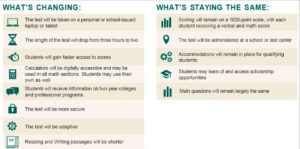The Digital SAT: An Inside Look
. Posted in SAT Test Prep, SAT tutoring
The College Board has announced plans to shift the SAT to an entirely computer-based format, trading the traditional paper test booklets and No.2 pencils for a smarter, shorter, digital test experience. Moreover, the digital SAT will be an adaptive test. Since College Board has now posted official specs and samples for the new SAT, here’s an overview of the information they released.
When, where, and what is it?
The new SAT will be released in the US in March of 2024 (March 2023 for international students). From that point, the SAT will only be available in digital format. The test will still be administered at schools and official test locations—you won’t be able to take the digital SAT at home.
Offering the SAT digitally allows for a much shorter test, helps students receive score results sooner (several days rather than several weeks), and presents content in a way that may be more comfortable for students. The digital format also allows for some new functionality, such as highlighting tools and an integrated graphing calculator (Desmos). Most importantly, the digital format allows for an adaptive test structure.
How is the SAT changing?
The new SAT will be adaptive. Adaptive tests use computer algorithms to calibrate the difficulty of test content to each student’s level. On the new SAT, students will take a Math section and a Reading & Writing section, and then the test will measure each student’s performance and make adjustments. If you do well, you get more challenging content on the next section. If you struggled, you get easier content. By offering targeted test material, the test can give accurate scores more efficiently.
The test will be shorter while maintaining its scoring accuracy, thanks to the benefits of the adaptive test structure. The new SAT will be 2 hours and 14 minutes long, significantly shorter than the current test length of 3 hours. Reading passages will be much shorter. This change will be the most significant difference in test content. Instead of passages up to 750 words long, as seen in the current test, the new SAT readings will only be up to 150 words long. Each of these short passages will include only a single question.
Two key features of the current SAT are not changing: content and scoring. For the most part, the concepts tested on the SAT will remain the same. The fundamental knowledge needed for the current test will still apply. While the Reading & Writing passages will be shorter, the questions will test the same skills that the current test does. On the Math side, the material will be nearly identical, with the only significant change being a slight reduction in wordiness. Also, the new SAT will retain the familiar 1600-point scale.

How will adaptive testing work on the new SAT?
An adaptive test evolves in response to a student’s performance. Whereas the current SAT is static, with each student receiving the same test form, the new SAT will adjust the difficulty of test content to best suit each student’s skill level. The Math portion and the Reading & Writing portion of the new SAT will each be divided into two modules. The first module will have a wide range of difficulty among the questions. Based on each student’s performance on the first set of modules, the second set of modules will offer targeted, customized content. This adaptive structure allows for a more precise measure of student skills, so the test can offer accurate scores with fewer questions.
How will the test be structured?
With the traditional SAT, there is a wide variety of difficulties throughout the test. Some questions may be too simple or too difficult for a student. Many questions are needed so that one standardized test form can provide enough data on students across different skill levels.
With the new adaptive SAT, the first modules offer a range of difficulty. Students’ performances on the first modules determine if the next modules should be easier or more difficult. The second set of modules is adapted to each student’s skill level, so each student will have a unique, customized set of questions. Fewer questions are needed because the data from the adapted module is more relevant, making it easier to gauge each student’s skill level. There are multiple benefits to adaptive testing, including increased security and reduced testing time. There can also be drawbacks, such as the inability to provide copies of the test questions.
Does this affect me? When do I need to be ready?
Students in the class of 2025 will be the first main group to take the digital SAT. The new test will be available in the spring of 2024 when these students are halfway through their junior year. Current rising juniors, the class of 2024, will be unaffected by this change. For international students, the shift comes earlier. Students taking the SAT internationally will be given the digital test starting in spring 2023. Summit will offer proctored practice tests and full prep programs for this first group of digital SAT test-takers—stay tuned for more details!
What about the ACT?
As of now, the ACT seems to be sticking with its pencil-and-paper test. While the SAT seeks to innovate and evolve, the ACT is maintaining a steady course. Perhaps the ACT is counting on students sticking with the reliable, traditional option, or perhaps they have unannounced plans for digital testing. The ACT already has a digital option for international test-takers, so it is possible that they will expand this option to domestic students.
Need help preparing for the SAT? Boston Tutoring Services is ready to support your family. For more information, please click here.
Allison Green
Boston Tutoring Services
